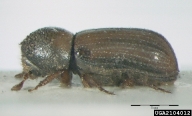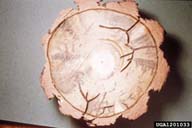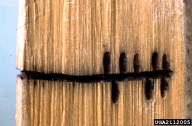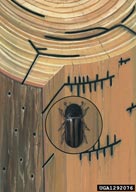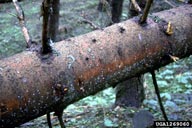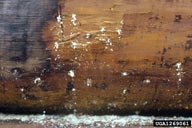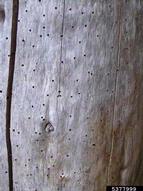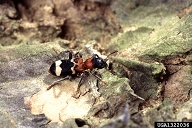Striped ambrosia beetle
Trypodendron lineatum (Olivier) (Coleoptera: Curculionidae, Scolytinae)
Orientation to pest
The striped ambrosia beetle, Trypodendron lineatum (Olivier), has long been considered the most damaging ambrosia beetle in the western United States (but see also the walnut twig borer, Pityophthorus juglandis Blackman). It is particularly important in coastal areas of British Columbia in Canada. Attacks are principally on dead and dying timbers created by wind storms, fire, bark beetle attack, or long in-field storage of cut logs. Females bore into the xylem and then larvae make lateral galleries where they feed, pupate, and later emerge. There is generally one generation per year.
Hosts commonly attacked
Striped ambrosia beetles attack conifers in Abies, Picea, Pseudotsuga, Tsuga, Larix, and Pinus. They rarely attack hardwoods.
Distribution
The striped ambrosia beetle is Holarctic in distribution. In the western United States, it is found from New Mexico and southern California to the northern edge of the boreal forest in Canada. In the eastern United States, it is found in New England and along the Appalachians to the mountains of western North Carolina.
Images of striped ambrosia beetle
| Figure 1. Adult of the striped ambrosia beetle, Trypodendron lineatum | Figure 2. Galleries of striped ambrosia beetle: (left) galleries made by females to access interior of log; (middle) the up and down galleries off the adult's gallery made by larvae; (right) diagram of the spatial relation of the two types of galleries inside a log | ||
| Figure 3. Emergence holes (see sawdust) of striped ambrosia beetles in felled Norway spruce (Picea abies [L.] Karst.) | Figure 6. Emergence holes of striped ambrosia beetles | Figure 7. Thanasimus formicarius, a clerid predator that likely feeds on striped ambrosia beetle | |
Important biological control agents related to this pest species
Little is know of the natural enemies of this ambrosia beetle. The clerid Thanasimus formicarius (L.) responds to the pheromone of T. lineatum, which suggests that it may use the striped ambrosia beetle as food.
Web links for information on striped ambrosia beetle
- Fact Sheet and Management Guide from FETCH 21 | University of British Columbia
Includes short video of damage from this beetle to stored logs - Biological Control Bulletin on BarkBeetles.org | USDA Forest Service
Articles
- Lindgren, B. S., S. E. R. Hoover, A. M. MacIsaac, C. I. Keeling, and K. N. Slessor. 2000. Lineatin enantiomer preference, flight periods, and effect of pheromone concentration and trap length on three sympatric species of Trypodendron (Coleoptera: Scolytidae). The Canadian Entomologist 132: 877-887.
- Park, J. and M. L. Reid. 2007. Distribution of a bark beetle, Trypodendron lineatum, in a harvested landscape. Forest Ecology and Management 242 (2/3): 236-242.
